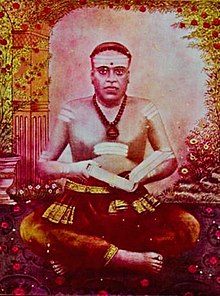Arumuka Navalar | |
|---|---|
| ஆறுமுக நாவலர் | |
 | |
| Born | Kandharpillai Arumukapillai 18 December 1822 |
| Died | 5 December 1879 (aged 56) Jaffna, British Ceylon |
| Other names |
|
| Education | Tamil Pandithar |
| Occupation | Hindu missionary |
| Known for | Hindu reformer |
| Title | Navalar |
| Part of a series on | |
| Hindu philosophy | |
|---|---|
 | |
| Orthodox | |
|
|
|
| Heterodox | |
|
|
|
Arumuka Navalar (Tamil: ஆறுமுக நாவலர், romanized: Āṟumuka Nāvalar, lit. 'Arumuka the Orator'; 18 December 1822 – 5 December 1879) was a Sri Lankan Shaivite Tamil language scholar and a religious reformer who was central in reviving native Hindu Tamil traditions in Sri Lanka and India.[1]
Navalar's birth name was Nallur Arumuka Pillai.[2] He was born in a Tamil literary family, and became one of the Jaffna Tamils notable for reviving, reforming and reasserting the Hindu Shaivism tradition during the colonial era. As an assistant working for Peter Percival – a Methodist Christian missionary, he helped translate the King James Bible into the Tamil language.he established Hindu schools and published a press in order to publish reading materials for Hindu children to educate them on Hindu religion and also practice and rituals of Hindu religion.[3][2] With his knowledge of Christian theological premises, Navalar became influential in creating a period of intense religious rivalry with Christian missionaries, defending Tamils and their historic religious culture in India and Sri Lanka, preventing large-scale conversions to Christianity.[2][4][5]
He was one of the first natives to use the modern printing press to preserve the Tamil literary tradition. He defended Hindu Shaivism, calling it samaya (Observance, Religion) of "True Being" (sat, soul), and he used the same techniques to counter Christianity that Christian missionaries used against Hinduism.[2] As part of his religious revivalism, in a manner similar to Christian mission schools, he built schools that taught secular and Hindu religious subjects.[2] He is credited with finding and publishing original palm leaf manuscripts. He also attempted to reform Hindu Shaivism and customary practices in Sri Lanka,[6] such as by showing Shaiva Agamas (scriptures) prohibit animal sacrifice and violence of any form.[2]
- ^ Holt, John (13 April 2011). The Sri Lanka Reader: History, Culture, Politics. Duke University Press. p. 460. ISBN 978-0822349822.
- ^ a b c d e f Dennis Hudson (1996). Raymond Brady Williams (ed.). A Sacred Thread: Modern Transmission of Hindu Traditions in India and Abroad. Columbia University Press. pp. 23–37. ISBN 978-0-231-10779-2.
- ^ Kamil Zvelebil (1974). Tamil Literature. Otto Harrassowitz Verlag. pp. 235–236 with footnotes. ISBN 978-3-447-01582-0.
- ^ Sugirtharajah 2005.
- ^ Jones & Hudson 1992, pp. 27–35.
- ^ Pillay, Kolappa Pillay Kanakasabhapathi (1969). A Social History of the Tamils. University of Madras.